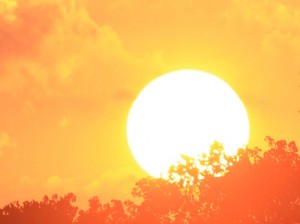I thought it might be relevant to share my experience growing up in Southern New Mexico, an area deeply infused with Native American culture and historical significance. I grew up in Deming, NM between The Gila National Forest and the Mexican border, west of the White Sands Missile Range.
In my hometown, there are Native families that carry the traditions. Pueblo murals are everywhere and Native artifacts make up most of our little museum. There are highly publicized Pow Wows just a few hours north of us. The cliche "Indian" symbolism really is everywhere, for the sake of tourism. There are the casinos, and the occasional blocking of the Interstate by the Reservations for political reasons. Most of the people that live in New Mexico, though, tend to understand the importance of the People that used to live there freely.
In Elementary School, we recited the Pledges to the US Flag and the New Mexican Flag every morning.
"I salute the flag,
Of the State of New Mexico,
The Zia Symbol of perfect friendship.
Among United Cultures."
The Zia is a symbol of the Sun. You can see the significance of the number four in the Zia symbol. There are four groups of four sun rays. In elementary school we learned that the Circle represents life and and the rays represent the directions (North, South, East and West) and the seasons. We also learned that the rays represent many different cultures coming together, connecting in the circle of life. I found a
blog post that goes into the symbolism in greater detail is you are interested.
A lot of people in the area, like anywhere, claim to be partly Native. The thing about New Mexico is that the culture is deeply alive in the people. Many of Native descent still show some interest in their culture (heck, even the snowbirds at least like to wear "inspired" jewelry and clothing). In the fifth grade we had a classmate whose brother took part in sun dances and other Native American rituals. He came to class and shared his experiences, which included piercing the skin of his chest with bone, tied by leather chords to a pole and pulling until the strings (or his skin) broke. He also told stories and sang for the class.

The Storyteller is an iconic image that I grew up with. The stories are a central part of Native American pride and history, so the Navajo and Pueblos both make statues like this one, sand paintings and dolls to represent the importance of the storyteller in their culture. Coincidentally, here in Ohio I have a 92 year old neighbor. Her husband was from Albuquerque and she has a case of these dolls in her home and his grandmother's handwoven rug on her wall-proof that the cultural pride runs deeply.
The Kachina Dolls are Hopi, which are more identified with Arizona. However, the Native Americans didn't recognize our state lines, and Tuscon is about three hours from my hometown. Kachina Dolls were originally meant for ceremonies or for learning, not for play. They represent ancestors, important figures in the culture, etc. Now, you can buy a Kachina doll easily online or at any touristy "trading post" in the Southwest.
Zunis, Pueblos and all the Pueblo Tribes, Mimbres, Navajo, Sandia, Apache, Hopi...the list goes on. There are twenty two native tribes of New Mexico. When I think about the sheer number of people that were corralled in the Four Corners it still shocks me. It was unnatural to force so many tribes and nations in such a small area.
It's hard to explain if you haven't been there, but New Mexico is very alive. The Native culture persists on some level today, though it obviously is a shadow of the past, as well as an infusion of our time and old symbolism. There are still remnants of the past, large and small. The Gila Cliff Dwellings are like a fossilized village etched in the sides of the Mountains. On a smaller scale, it isn't terribly uncommon to find arrowheads and small shards of pottery in the desert where I grew up, as well as fossils on the rock that bring a lot of visitors every year.
So, that's a kind of wordy post about my experience with native American culture. If you are interested, I included some links. If you ever have a chance to visit the Southwest I highly recommend it, there's nothing quite like it.
Gila Cliff Dwellings
Navajo blog and Creation Story
The Mimbres "Indians" (from my area)
The Trail of Tears















